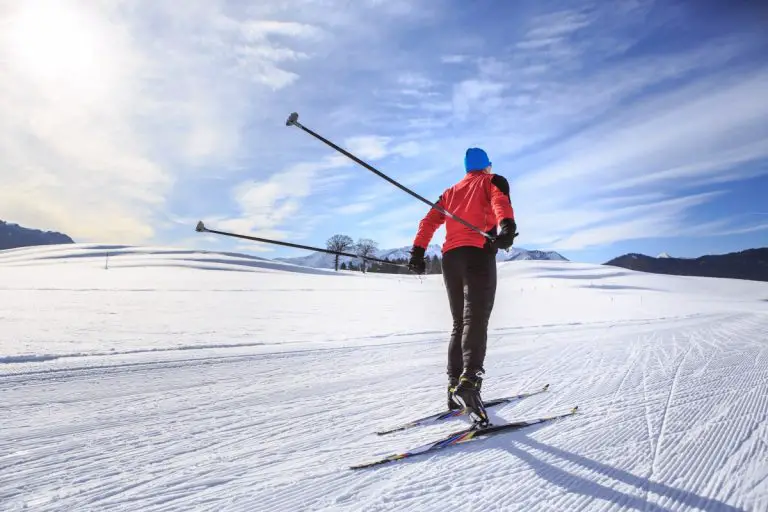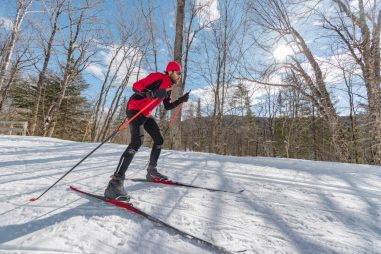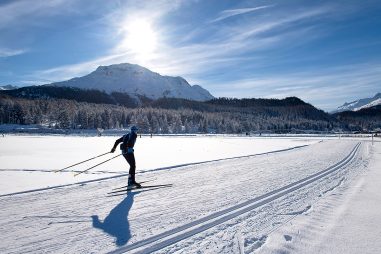Skate skiing is the fastest of the Nordic skiing styles. Its movements are closer to ice skating but with more coordination, power, and endurance. And compared to classic Nordic skiing, skate skiing has a steeper learning curve because of the mechanics and techniques that will take hours to master. But once you get the hang of it, skate skiing is a fun ride that you’ll keep coming back to. So here’s everything you need to know about this fast ski sport.
Is Skate Skiing More Fun?
Speed is what makes skate skiing more fun than the classic style. With skate skiing, you can go as fast as your strength and endurance will let you. However, it’s generally harder to learn because of its mechanics and technique. But once you’re able to get yourself moving, you might get addicted to the speed and the rush you’ll experience as you ride on well-groomed trails.
How Did Skate Skiing Start?
Skate skiing started as a necessity in the 1930s. During this era, people would ski using skating movements to travel across flat terrain. This significantly cut their travel time when traversing flat terrain. From there, the technique eventually found its way into ski marathon racing where it quickly revolutionized the sport.
When Did Skate Skiing Begin?
Skate skiing was introduced in competition in the 1970s during the ski orientation marathon wherein participants have to race from one point to another with the help of a map.
The technique also made an appearance in the 1980 Swedish skiing marathon. The race was done on a flat surface, making it possible to skate ski. From there, it caught on to the rest of the world.
The technique was used again in the 1982 World Ski Championships. In 1984, more skiers started using this technique which resulted in ski racing divided into two categories the following year — freestyle skiing which included skate skiing and classic skiing.
Who Started Skate Skiing?
It was Pauli Siitonen, a top Finnish skater, who was credited for first using the technique in the 1970 ski orientation event.
In the 1980 marathon, it was an American skier, Bill Koch, who used this technique after seeing it from other skiers who followed Siitonen’s skate style. Koch used the same style in the 1984 World Ski Championships that allowed him to win as the overall race champion.
How Does Skate Skiing Work?
Skate skiing is the equivalent of racing on snow. But unlike running, your movements are more similar to ice skating or rollerblading.
With balance and body control, you move forward by using your skis to slide and glide from one side to the other. You get more momentum and you can increase your speed by pushing off with your poles. The more power you have to push off with your legs and poles, the faster you can go.
Is Skate Skiing Like Ice Skating?
The lower body movements of skate skiing are the same as ice skating. The balance needed is also the same but that’s where the similarities end.
The most obvious difference is the gear needed. Skis are way different than skates plus you use poles. This makes the upper body movements different in skate skiing since you utilize your poles to add more power and propel your body forward.
How Do You Do Skate Skiing?
To skate ski, you push off from one leg and glide forward with the other. Unlike classic skiing where you move your legs forward as if you’re walking, you glide in a diagonal direction. Your skis are also pointed outwards in a V shape.
And while you push and glide, you utilize your poles to give you additional momentum to push you forward and let you go faster. It’s like a dance that requires total body control, coordination, and balance as you ski with rhythm.
How Do You Start Skate Skiing?
To start skate skiing, you need to practice your stance and balance. These are the fundamentals that you need to master. Since you move and push off with one leg at a time, getting in the right position gives you balance and prevents you from falling on your face.
You start skate skiing by practicing the skate movements first without the poles. This is where balance comes in.
- Athletic Stance: feet are hip-width apart, with knees slightly bent. In this position, do a few quick hops and land on the balls of your feet. Each time you land, you should be in the same stance. This helps you achieve a good balance with your skis.
- Balancing on One Foot: In an athletic stance, lift one foot and brace your core. You should be able to maintain the athletic stance even on one leg. Repeat on the other leg.
Once you’re comfortable with your stance and balance, you can start skiing by pushing off one leg and gliding forward in a diagonal direction using the other leg. Do this slowly until you find your rhythm.
After finding your skating rhythm, you can start using your poles. Skate skiers employ a double pole method, one of the basic movements of the sport. With this method, you push down on your poles simultaneously.
Remember, it might take a while for you to get the timing and coordination right. And that’s ok since skate skiing has a steep learning curve. The key is to be patient and keep practicing.
How Do You Stop on Skate Skis??
There are three methods to stop on skate skis: snow plow stop, snow plow turning, and hockey stop.
- Snow Plow Stop: The easiest and most effective way to stop on flat terrain. To do this, you slowly push your skis outward and let the front ends of your skis meet to create a tip of a triangle. The wider the angle, the faster your speed will decrease.
- Snow Plow Turn: Also called the wedge turn stop, it has the same mechanics as the snow lough stop but you apply more pressure on one leg. This forces you to turn as you come to a stop, which is effective if you want to avoid people or objects.
- Hockey Stop: An advanced stopping method, this requires being able to do a parallel turn. Here you turn your legs until the skis are sideways parallel while digging in on the snow at the same time. This lets you make an abrupt stop, like hitting on the brakes real hard.
How Fast Can You Go Skate Skiing?
You can go really fast skate skiing. It’s generally 10% faster than the classic skate skiing style. But some factors affect how fast you can ride, specifically the terrain conditions, your conditioning and body type, and your equipment.
What Is a Good Pace for Skate Skiing?
The average speed for recreational skate skiers is 10 to 20 mph (16 to 32 kph) on flat terrain while professional racers can go beyond 20 mph (32 kph).
When going downhill, speeds can reach up to 40 to 60 mph (64 to 97 kph) for average skiers and pros can go as fast as 75 to 90 mph (120 to 145 kph).
Do You Need Different Skis for Skate Skiing?
Skate skiing requires a different set of skis compared to the skis used for classic or touring styles. Skate skis have the following characteristics:
- Shorter Length: It allows you to lift your skis easily with each forward glide. They’re also more stable than longer skis.
- Narrow Width: This lets you move faster since narrow skis enable you to glide quicker on the trail.
- No Sidecuts: These long, inward side curves are non-existent in skate skis. This gives you more control and makes them easier to set on edge as you skate.
- Slight Camber: It’s the arch the ski has and skate skis have only a slight bend. This allows you to push off with more control and efficiency.
- Waxable Base: Your gliding movements are based on traction and the waxable bases give you more traction and momentum.
- Stiff Flex: A stiff flex gives you more power and stability which are essential given the style’s skating movements.
How Stiff Should Skate Skis Be?
A ski’s flex is defined by its stiffness and for skate skis, they need to have a stiffer flex. This gives you more stability and generates more power which is essential for acceleration and speed. Stiffer skis are also designed for speed as they push off nicely against the snow.
However, you don’t want your skate skis to be too stiff. These aren’t as responsive and won’t give you the control you need to navigate the terrain.
What Size Skate Ski Do I Need?
The skate ski you need depends on your height and technical skills. This will allow you to use skis more adapted for your skill level.
Skate skis are generally shorter and narrower than classic cross-country skis, usually by 4 inches (10 cm). The short length allows you to easily pick up the skis with every stride and they offer more stability and glide.
As for its width, skate skis are generally 1 1/2 inch to 2 inches (41mm to 45mm) wide at the tip. This narrower width gives you a faster ride and glides easily on groomed tracks.
When considering your skill level, beginners should use shorter skis while more advanced skiers can go with longer skis.
How Do You Know What Size Skate Ski to Get??
Here’s a chart that shows your recommended ski size based on your height. It may vary for ski manufacturers, so it’s better to check their recommendations.
| Height | Height (cm) | Ski Size (cm) |
| 5’11” – 6’4” | 180.3 – 193.0 | 195 |
| 5’9” – 5’10” | 175.3 – 177.8 | 190 |
| 5’7” – 5’8” | 170.2 – 172.7 | 185 |
| 5’5” – 5’6” | 165.1 – 167.6 | 180 |
| 5’3” – 5’4” | 160.0 – 162.6 | 175 |
| 5’1” – 5’2” | 154.9 – 157.5 | 170 |
For kids, their ski length is computed based on their level. For beginners, subtract 2 to 4 inches (5 to 10 cm) from their height. For advanced kids, you add 2 to 4 inches (5 to 10 cm) to get their ski size.
Do Skate Skis Wear Out?
Skate skis wear out like any equipment. They can last you a few years depending on your aggressiveness on the trail and how you maintain your gear. When you experience a performance dip, it’s one of the tell-tale signs that your skis are worn out.
How Long Do Skate Skis Last??
Good quality skate skis usually last between 3 to 5 years if you’re an average skier, shorter if you ski often and if you ride aggressively. After this period, you’ll notice your skis won’t perform as well and will lack the energy you need on the snow.
How Long Does Skate Ski Wax Last?
Skate skis have a base that needs to be waxed regularly so they can repel water effectively. The wax will last you 4 to 5 ski rides but you may need to do it more frequently depending on how often and how hard you ski.
One thing you want to avoid is oxidation or the whitening of the ski base. Regular waxing prevents this from happening but once it does, it’s a sign that your skis are losing their water-repelling properties.
What Are the Best Conditions for Skate Skiing?
Skate skiing is best done on wide-open terrain that allows you to move freely and practice safely. The terrain should have well-groomed snow as it offers more stability and is safer especially for beginners. Meanwhile, icy or slippery terrain is slippery and isn’t ideal for skate skiing.
What Is the Best Temperature for Skate Skiing?
For many people, temperatures between 15°F to 20°F (-9°C to -6°C) are the best for skate skiing. For new snow, closer to 20°F (-6°C) is better, while closer to 15°F (-9°C) is best for old snow.
At these temperatures, you’ll be able to ski comfortably without feeling too cold or too warm. But you’ll also have to consider how heavy the winds are in the area.
Another consideration is the snow condition. If the temperature is too high and is causing the snow to melt, you’ll end up with slippery terrain. On the other hand, too much fresh and ungroomed snow will make it harder for you to move.
Can You Use Skate Skis on Classic Trails?
Skate skis are designed for sliding and gliding and this makes them impossible to use for the striding movements required by classic trails. You’ll have to switch to skis that are meant for the classic trails.
Can You Skate Ski on Ungroomed Trails??
It’s still possible to skate ski on ungroomed trails, however, you might find it extremely difficult. With ungroomed trails, you don’t know the snow’s thickness or if they’re compact enough for you to be able to skate properly. Skate skis aren’t designed to handle ungroomed terrain, so you’d be better off using the touring style if you plan to go off-trail.
Can You Skate Ski on Ice?
In general, skiing on ice takes a lot of practice and effort. And while not impossible, it’s very difficult to skate ski on ice. Your skis can encounter less friction on ice compared to snow which can make skiing more challenging. Also, an icy surface can become very slippery at certain temperatures. It’s easy to lose control and fall down.



